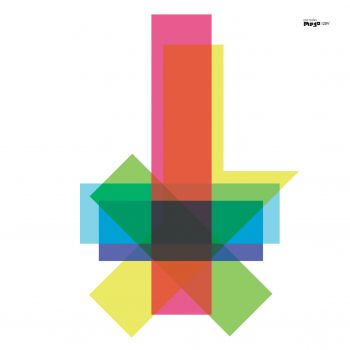Mark Fell’s surprisingly bright and colourful artwork hides a dark and wondrous monster of an album, the long-awaited latest chapter in KTL’s enthralling saga of sonic unease. Yet if the cover doesn’t quite herald the kind of synth explorations that have started to crop up on a lot of noise musicians’ work of late, V does see Stephen O’Malley and Peter Rehberg develop the sonics of their palette in new ways.
The music of KTL is anchored in the lowest frequencies of both electronics and guitar, and the first half of V perpetuates this obsession, ‘Phill 1’ evolving patiently and murkily via intense drones that envelop and submerge the listener – smothering, claustrophobic yet at the same time beautifully textured, with O’Malley’s restrained guitar tone rumbling away underneath a duvet of dense modular synth lines… or rather one line, extended and amplified until it fills every nook and cranny of space and even, if you listen to it in the right frame of mind, time. This power, this all-encompassing envelopment that the duo creates, has long been their signature, and its stamped on the entirety of V, with the same brutality as before, but with an extra injection of subtle elegance.
The description on Editions Mego’s website mentions that V "tackles the complex working processes of the European avant-garde", and you can certainly detect an influence of a piece like Alexander Knaifel’s gentle, subtle Blazhenstva, or even the music of Arvo Part, on ‘Phill 1’ and its partner track, ‘Phill 2’, on which string arrangements by Johan Johannson performed by The City of Prague Philharmonic Orchestra meld with the nebulous sounds conjured up by KTL, circling their dank drones with flights of moody yet symphonic grace.
On ‘Phill 2’, and the bass-heavy, anxiously percussive ‘Tony’, at times all sounds seem to recede, leaving gaps that feel like air filtered into a airtight room. Indeed, lulls, restraint and near-silence crop up across V, feeling like a ballast against the grim murk conjured up by O’Malley and Rehberg, opening up the vista of their music and again throwing back to the hesitant modern composition of Knaifel or even Cornelius Cardew.
On ‘Study A’ and ‘Tony’, however, their gaze seems to also cross the Atlantic, with the electronic and metallic drones stretched out and reinforced with a focus and tonal emphasis that evokes American avant-garde minimalist masters such as Pauline Oliveros, LaMonte Young and Tony Conrad. ‘Study A’, in particular, sees Rehberg’s synth drones come remarkably close to sounding like a sustained violin tone, and V has a similar ability to swallow the listener up like a musical whale as works like ‘Four Violins’ or ‘Inside The Dream Syndicate’, although KTL’s marine mammal has pretty razor-sharp teeth.
This diversity, even one so well-anchored in familiar formal territory (nothing ever lets you forget that this is a KTL album), gives fresh impetus to O’Malley and Rehberg’s music. Albums I and II, their most complete works to date, were powerful and absorbing, but with an emphasis on the kind of post-metal dark ambience that anchored them resolutely in a sub-genre of drone where atmosphere of the most deliberately terrifying kind primed over texture and experimentation. "Horror music", I like to call it, and while it is a sub-sub-genre that has thrown up many sordid delights of late (Failing Lights, Xela, William Fowler Collins and Black Mountain Transmitter, to name but four), I always felt that, with Rehberg and O’Malley’s pedigree, KTL could – and would – eventually go further. They’ve done that emphatically with this latest opus.
The second half, in particular, is astounding, as Johansson’s aforementioned string arrangements on ‘Phill 2’ build a majestic frame around the crackling, ghostly atmospheres of his collaborators, edging the piece ever upwards even as the subsonics at the track’s core drag it into a well of near-total obscurity. The album then closes on a note of sheer, unmitigated horror, as if to both drag KTL back to their roots and use their experimentation to pass definitively through the mirror and over to a land of shadows and nightmares. ‘Last Spring: A Prequel’ is based on a piece written by long-time collaborator Dennis Cooper, the notorious author of provocative, murderous gay fiction; and the text is spoken, in French, by Jonathan Capdevielle, a collaborator of artist Gisele Vienne, whose installation lent the track its title and serves as its atmospheric template.
Capdevielle’s vocals on ‘Last Spring: A Prequel’ are nearly impossible to describe. Seemingly taking on two characters, or a schizophrenic arguing with his own internal demon, he switches with disturbing ease between a plaintive plea and a monstrous snarl that could have been taken directly from one of “possession” recordings in the Okkulte Stimmen collection. His rasps, moans, cries, whispers and poisoned invectives creep towards the listener, feeling like a presence in the room, whilst KTL unfurl a haunted atmosphere of blighted, quiet phantasmagoria, as if tuning a radio to pick up the unintelligible voices of evil ghosts hovering just behind a veil of ectoplasm. The piece had me fidgeting with both disquiet and marvel, and it took a while for me to clear my head of it.
V cements KTL as more than just a side-project of two of modern underground music’s most celebrated figures, crystallising their vision and expanding it beyond everything that they – and other drone artists operating in the same field – have done before. It retains their sinister stamp, but takes the fear into new realms, like demons breaking out of the ground into muted sunlight.


